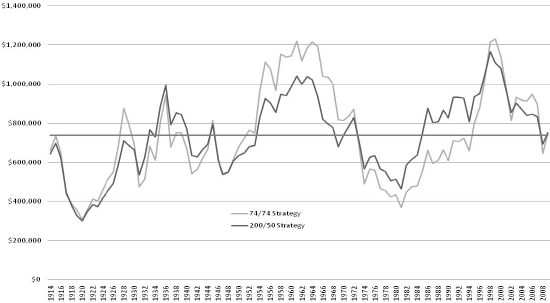Should long-term investors view their retirement portfolios more like houses than savings plans? In other words, should they start out with considerable leverage and draw the leverage down gradually over time? In their October 2010 paper entitled “Diversification Across Time”, Ian Ayres and Barry Nalebuff investigate the effects of initially implementing and then gradually phasing out leverage for long-term (retirement) equity investment. This strategy exploits the large present value of investments made early in life, while protecting accumulated wealth from equity market volatility late in life. Tests limit initial leverage to 200%. Using return data for U.S. stocks and margin interest rate estimates over the period 1871 through 2009, they conclude that:
- Over the entire sample period, U.S. equities generated an annualized nominal return of 8.83%, while the comparable cost of margin was 5.01%. The 3.82% difference drives the benefits of leverage early in life.
- For example, by more evenly spreading exposure to equities over time, a portfolio with 200% initial allocation to stocks produces on average the same terminal value as one with a constant 75% allocation to stocks, but realizes a 21% smaller annual standard deviation .
- In general, derivative markets have made it inexpensive to apply 200% leverage. Alternative sources of reasonably low effective margin interest rates include:
- Margin loans from aggressive brokers.
- Leveraged index funds.
- Stock index futures.
- Deep-in-the-money, long-range call options on stock indexes (perhaps the most cost-effective approach).
- The strategy is generally robust to moderate reductions in the the spread between equity return and margin interest rate, and has little margin call risk.
- The strategy also outperforms constant equity exposure for UK and Japanese stock indexes.
The following chart, taken from the paper, plots the terminal values for 96 cohorts of investors after a 44-year investing lifetime (with uniform income profile) starting in 1871 and ending in 2009 based on two comparable strategies:
- The 200/50 strategy initially invests 200% of liquid savings (4% of income annually) in the stock market and ramps this percentage down to 50% as retirement approaches.
- The 74/74 strategy invests a constant 74% of liquid savings in the stock market, producing the same average terminal value as the 200/50 strategy (same effective stock market exposure).
The 200/50 strategy lowers volatility relative to the 74/74 strategy, essentially channeling the incremental benefits of better diversification across time to risk reduction. Other calculations demonstrate that the 200/50 strategy also outperforms a 90/50 strategy.

The authors note that the study “ignores the impact of human capital or housing investments on the optimal retirement investment.” As noted by a reader, to the extent that an investor’s labor income and home equity correlate with stock market returns, the investor should include these implicit dependencies on stock market performance in estimating stock market leverage.
In summary, evidence from a range of tests indicates that diversifying stock investments over time by using leverage when young offers a return/risk advantage at retirement over both a constant allocation and a declining but initially unleveraged allocation.
Other than the margin interest rate for leverage, the authors do not address costs of portfolio formation and maintenance. For example, index mutual funds and exchange-traded funds charge fees and incur trading costs that make them underperform their benchmark indexes. Moreover, such funds are not available for much of the sample period. Alternatively, investors creating their own index portfolios, whether from stocks or derivatives (available only late in the sample period), incur trading frictions via broker fees and bid-ask spreads. Realistic costs of portfolio formation and maintenance may materially dent the advantage of the early leverage strategy.